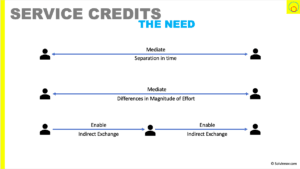Category: In Practice
Articles that explore topics in practice
Cash is everywhere - but what role does it have as we try and look at the economy as service-exchange based?
This is a preliminary view, where I look at cash rather than as a proxy for value, as being service tokens, which supports:
- mediation of temporal and magnitude differences in a service exchange
- enables indirect service exchange
Such a view still allows us to observe common aspects of cash (the desire to acquire as much as possible).
And allows us to maintain our improved view of value - relating to progress being made. In addition to service-service continuum and other behavioural quirks we see.
Need a way to discover new concepts for your service?
Blue Ocean Strategy contains a few tools that give a great way to look at and discover New Service Concepts (one of five dimension in our services innovation model).
We take Gallouj & Weinstein's idea that a service is a matrix of four sets of characteristics. And say those characteristics are the attributes in a Blue Ocean Canvas. Then, using the Blue Ocean Four Actions Framework we can ideate service concepts by either raising, reducing, creating or eliminating characteristics.
The resulting new service concepts nicely adhere back to Gallouj & Weinstein's categorisation of service innovations: radical, improvement, incremental, ad-hoc, recombinative (architectural) and formalisation
How difficult will it be to implement your innovation in your enterprise?
We look at how we can determine that through via den Hertog's model of service (which holds for products too). And take advantage that models of this type have two components:
- dimensions
- capabilities
By determining the size of change in dimensions and the strength of an enterprise's capabilties, we can score an innovation's Implementation Execution Complexity
In doing so, we open the path to reducing that score - perhaps simplifying the change, or improving capabilities. And to portfolio management.
Can service-dominant logic help us understand and harness the circular economy? Yes
We need to move from the linear economy of take-make-waste. An economy that parallels the embed-exchange-use up logic of goods-dominant logic.
And move to the circular economy. An economy that, amongst other things, aims to to minimise waste and pollution through reusing, sharing, refurbishing and recycling.
And that economy shares a lot with service-dominant logic. With looking beyond the exchange, co-ordination of resources and co-creation of value
This site started with The Innovation Problem - not least that 94% of executives are unhappy with innovation performance- and my experience starting a global innovation account's innovation function.
What is the solution?
That is what this article builds. Pulling out the lessons from all the articles on this site I am building a blueprint of an organisation and approach that doesn't suffer from the problems that lead
It is an article that is continually being updated and reformed as I go through my journey





